Fire Resistance of Fire-Protected Reinforced Concrete Beams Strengthened with Externally Bonded Reinforcement Carbon Fibre-Reinforced Polymers at the Full Utilisation Degree
Abstract
:1. Introduction
2. Materials and Methods
2.1. Test Specimens
- gypsum boards (GB) type GM-F, GM-H1, density of 850 kg/m3, thermal conductivity at 20 °C of 0.020 W/mK, single layer thickness of 25 mm;
- calcium silicate boards (CSB), density of 480 kg/m3, thermal conductivity at 20 °C of 0.009 W/mK, single layer thickness of 50 mm.
- B-1 and B-10—beams with CFRP strengthening, without fire protection, loaded below their bending capacity before strengthening;
- B-2, B-3 and B-9—beams with and without CFRP strengthening, with fire protection, loaded below their bending capacity before strengthening;
- B-4 to B-8—beams with CFRP strengthening, with or without fire protection, loaded above their bending capacity before strengthening.
2.2. Test Method
- Fire protection failure time (tFP), defined as the time when the temperature rise on the bottom surface of the concrete beam exceeds 50 K/min. Such rate of temperature rise can be observed only after fire protection detachment or significant deterioration.
- EBR CFRP failure time (tFRP), defined as the time of noticeable detachment of CFRP strips or sudden, short-term increase in the rate of deflection, being the result of strain redistribution after CFRP failure.
- Beam failure time (tR), defined as the time when the rate of deflection of 5 mm/min was exceeded, calculated in accordance with EN 1363-1 [19].
3. Results
- leaking joints between fire boards, allowing hot gases from the furnace chamber to penetrate the air gap surrounding the CFRP strip; the effect was amplified by conditions in the furnace, i.e., imposed overpressure of 20 Pa at the level of the underside of the beam;
- the placement of thermocouples in the vicinity of the load application points, i.e., the points with the highest possible deflection and in the vicinity of vertical cracks;
- other minor effects such as: outflow of water from the concrete, geometric imperfections of the fire protection boards and uneven adhesive thicknesses.
4. Discussion
5. Conclusions
- It is possible to fireproof reinforced concrete beams with EBR-CFRP, loaded above their load-bearing capacity before strengthening, and achieve more than 4 h of fire resistance. This has not yet been demonstrated in actual full-scale tests.
- Regardless of heating time (in the range from 1 to 300 min), failure of the EBR CFRP strengthening system was caused by achieving and exceeding the glass transition temperature of the adhesive, resulting in complete and rapid detachment of the CFRP. This resulted in the immediate achievement of fire resistance criteria (rate of deflection and, in many cases, collapse of the beam), but only for beams loaded over their load-bearing capacity prior to strengthening. In other cases, only a temporary growth of deflections was noted at that moment, with no influence on the further behaviour of the element.
- Until strengthening system failure, the beams demonstrated a small growth in deflections (about 5 mm, which is about 2% of the limiting value for the analysed experimental structure [19]). Also, higher values of deflections were registered for longer heating periods.
Funding
Institutional Review Board Statement
Informed Consent Statement
Data Availability Statement
Conflicts of Interest
References
- EN 1990:2002/A1:2005; Eurocode–Basis of Structural Design. CEN: Brussels, Belgium, 2005.
- fib Task Group 9.3. Fib Bulletin 14: Externally Bonded FRP Reinforcement for RC Structures; Fédération Internationale du Béton (fib): Lausanne, Switzerland, 2001. [Google Scholar]
- fib Task Group 5.1. Fib Bulletin 90: Externally Applied FRP Reinforcement for Concrete Structures; Fédération Internationale du Béton (fib): Lausanne, Switzerland, 2019. [Google Scholar]
- Committee, A.C. Guide for the Design and Construction of Externally Bonded FRP Systems for Strengthening Concrete Structures; ACI 440.2R-17; American Concrete Institute (ACI): Farmington Hills, MI, USA, 2017. [Google Scholar]
- Firmo, J.P.; Correia, J.R.; Bisby, L.A. Fire behaviour of FRP-strengthened reinforced concrete structural elements: A state-of-the-art review. Compos. Part B Eng. 2015, 80, 198–216. [Google Scholar] [CrossRef]
- Deuring, M. Brandversuche an Nachträglich Verstärkten Trägern aus Beton; EMPA: Dubendorf, Switzerland, 1994. [Google Scholar]
- Blontrock, H.; Taerwe, L.; Vandevelde, P. Fire tests on concrete beams strengthened with fibre composites laminates. In Proceedings of the 3rd International PhD Symposium in Civil Engineering, Vienna, Austria, 5–7 October 2000. [Google Scholar]
- Williams, B.; Kodur, V.; Green, M.F.; Bisby, L. Fire endurance of fiber-reinforced polymer strengthened concrete T-Beams. ACI Struct. J. 2008, 105, 60–67. [Google Scholar] [CrossRef]
- Adelzadeh, M.; Green, M.F.; Bénichou, N. Behaviour of fibre reinforced polymer-strengthened T-beams and slabs in fire. Proc. Inst. Civ. Eng. Struct. Build. 2012, 165, 361–371. [Google Scholar] [CrossRef] [Green Version]
- Ahmed, A.; Kodur, V. The experimental behavior of FRP-strengthened RC beams subjected to design fire exposure. Eng. Struct. 2011, 33, 2201–2211. [Google Scholar] [CrossRef]
- Firmo, J.P.; Correia, J.R.; França, P. Fire behaviour of reinforced concrete beams strengthened with CFRP laminates: Protection systems with insulation of the anchorage zones. Compos. Part B Eng. 2012, 43, 1545–1556. [Google Scholar] [CrossRef]
- Firmo, J.P.; Correia, J.R. Fire behaviour of thermally insulated RC beams strengthened with EBR-CFRP strips: Experimental study. Compos. Struct. 2015, 122, 144–154. [Google Scholar] [CrossRef]
- Kodur, V.K.R.; Bisby, L.A.; Green, M.F. Experimental evaluation of the fire behaviour of insulated fibre-reinforced-polymer-strengthened reinforced concrete columns. Fire Saf. J. 2006, 41, 547–557. [Google Scholar] [CrossRef]
- Chowdhury, E.U.; Bisby, L.A.; Green, M.F. Investigation of Insulated FRP-Wrapped Reinforced Concrete Columns in Fire. Fire Saf. J. 2007, 42, 452–460. [Google Scholar] [CrossRef]
- Cree, D.; Chowdhury, E.U.; Green, M.F.; Bisby, L.A.; Bénichou, N. Performance in fire of FRP-strengthened and insulated reinforced concrete columns. Fire Saf. J. 2012, 54, 86–95. [Google Scholar] [CrossRef]
- Runkiewicz, L.; Sieczkowski, J. Najczęściej popełniane błędy w projektowaniu konstrukcji budowlanych. Przegląd Bud. 2019, 5, 18–24. [Google Scholar]
- Harries, K.A.; Porter, M.L.; Busel, J. FRP Materials and Concrete-Research Needs. Concr. Int. 2003, 25, 69–74. [Google Scholar]
- EN:2016-12; Concrete–Part; Performance; Production; Conformity. CEN: Brussels, Belgium, 2016.
- F.R.T. 1363-1:2020; General Requirements. CEN: Brussels, Belgium, 2020.
- Węgrzyński, W.; Turkowski, P.; Roszkowski, P. The discrepancies in energy balance in furnace testing, a bug or a feature? Fire Mater. 2020, 44, 311–322. [Google Scholar] [CrossRef]
- Malendowski, M. Analytical Solution for Adiabatic Surface Temperature (AST). Fire Technol. 2017, 53, 413–420. [Google Scholar] [CrossRef] [Green Version]



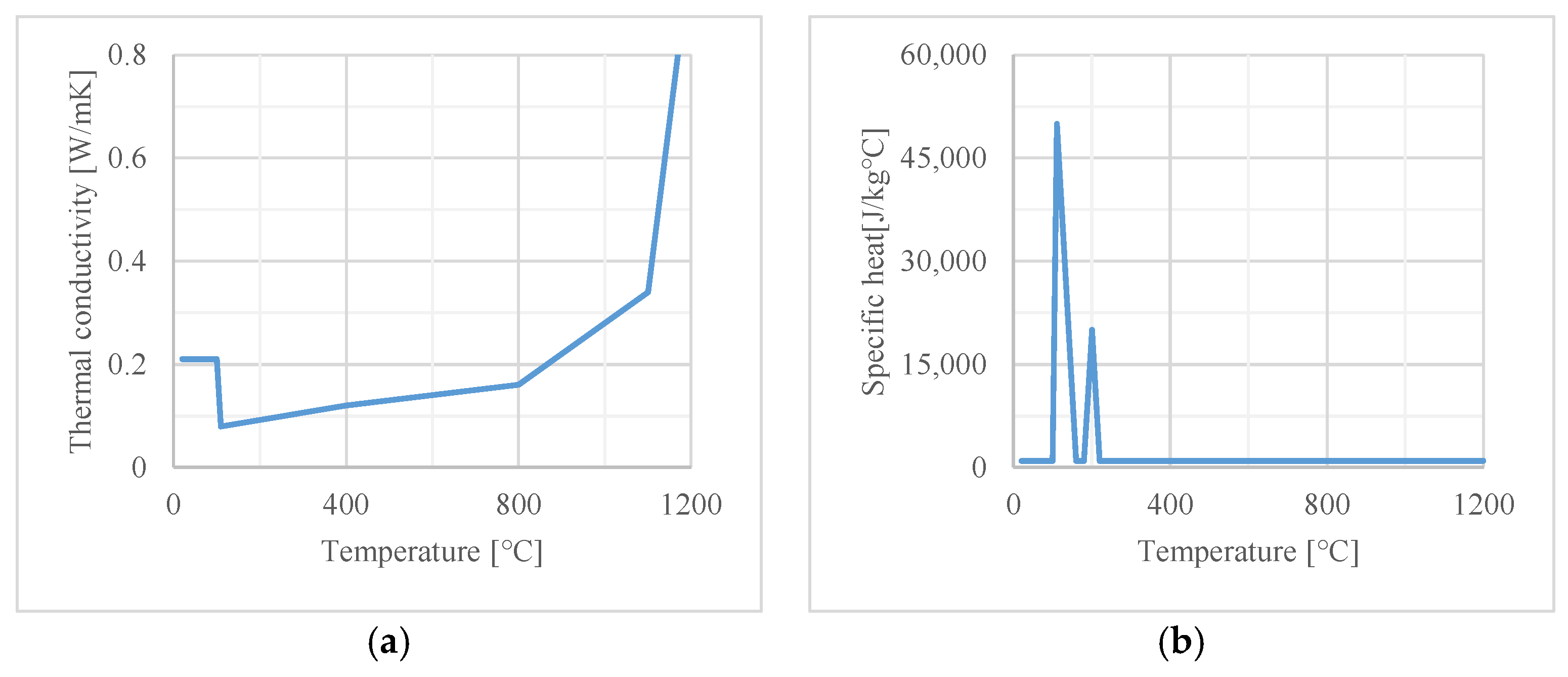
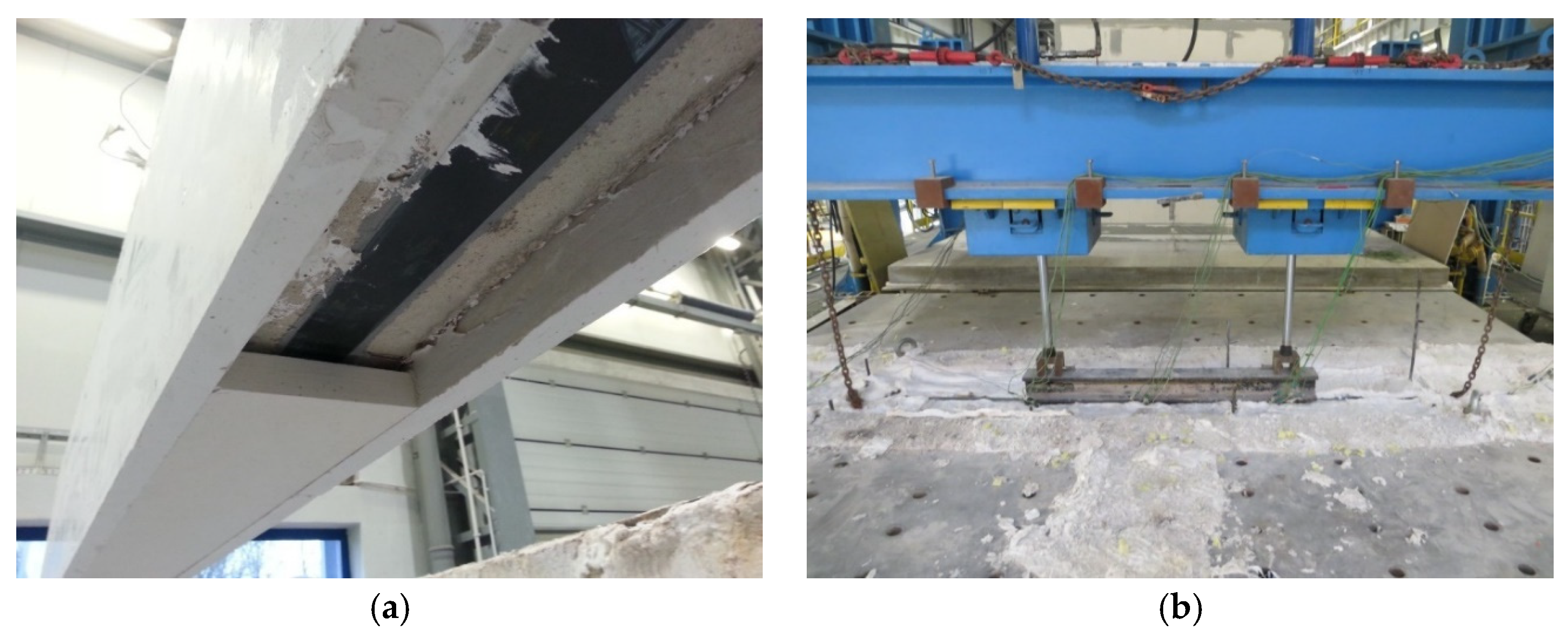
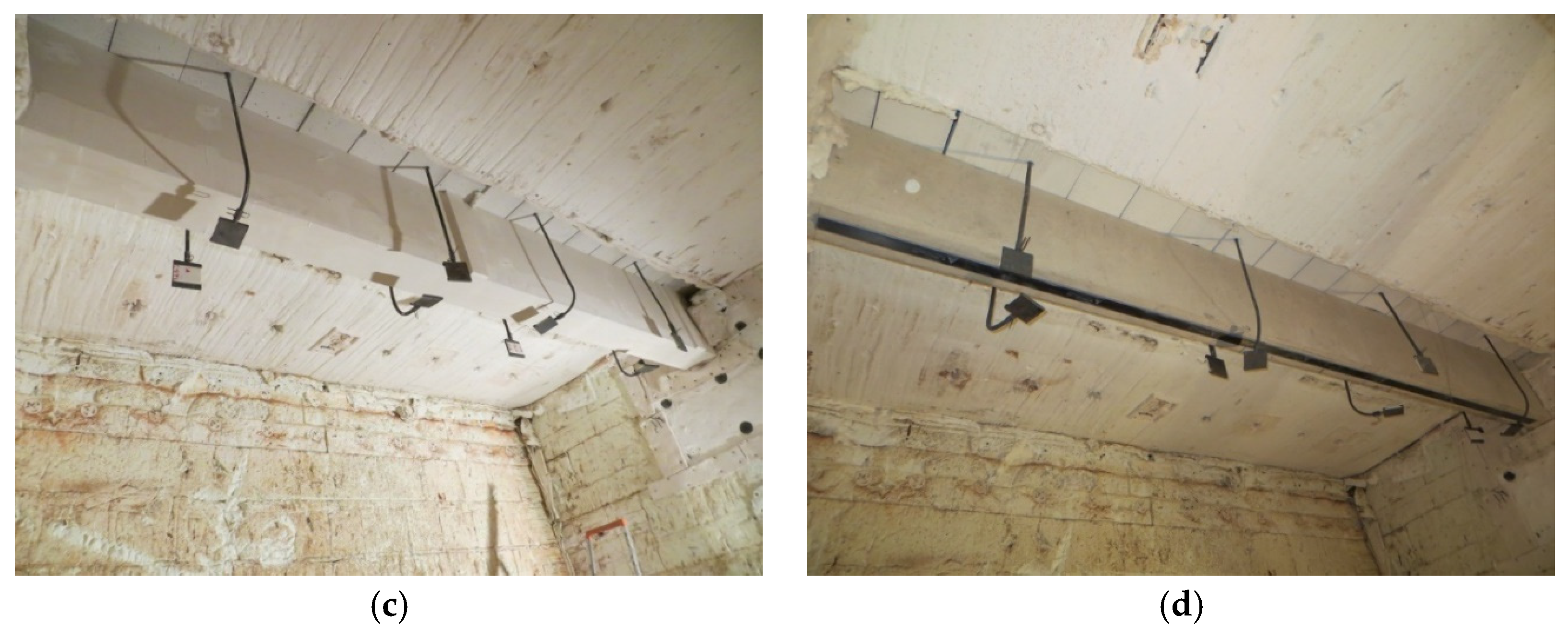

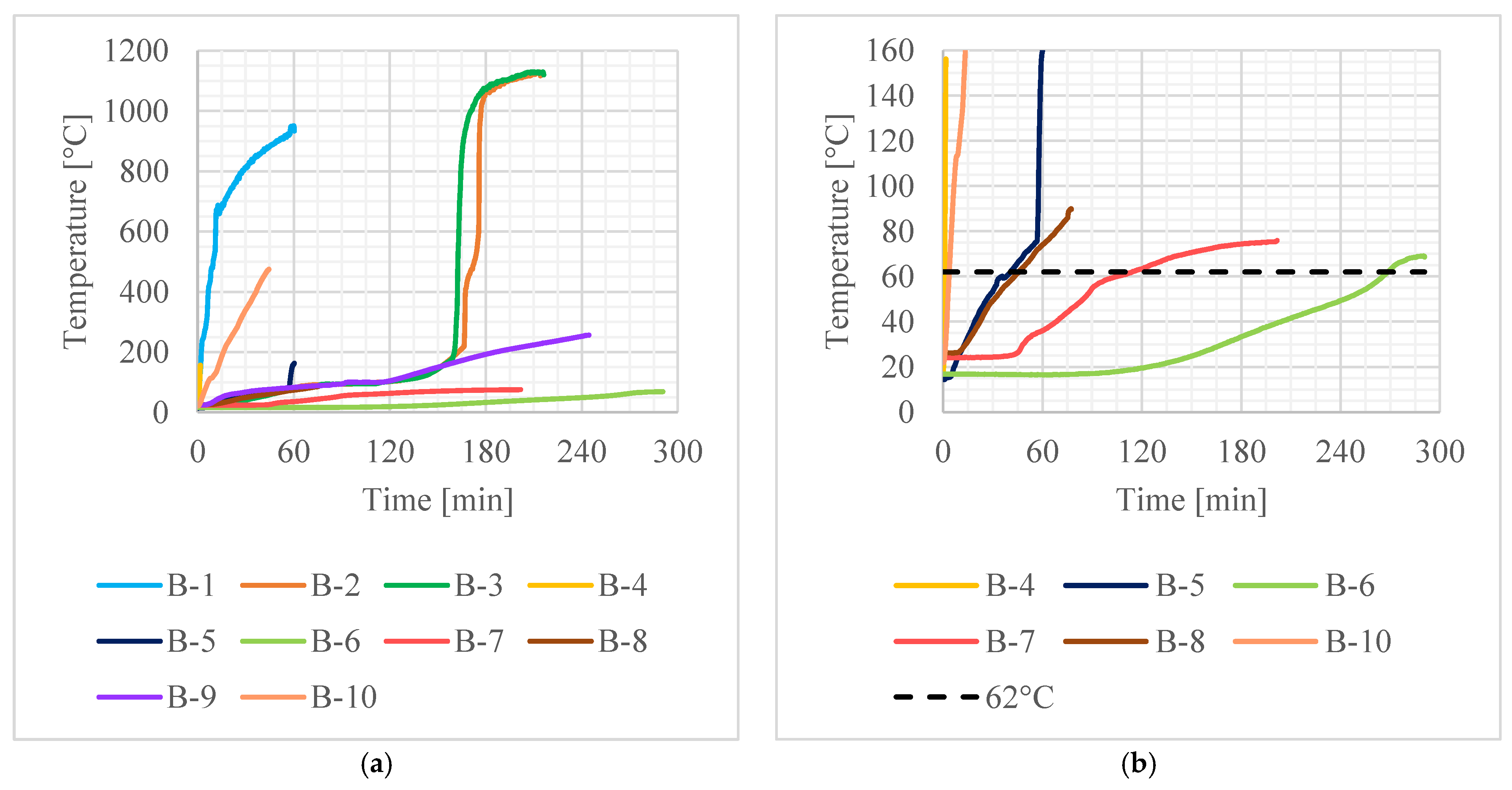
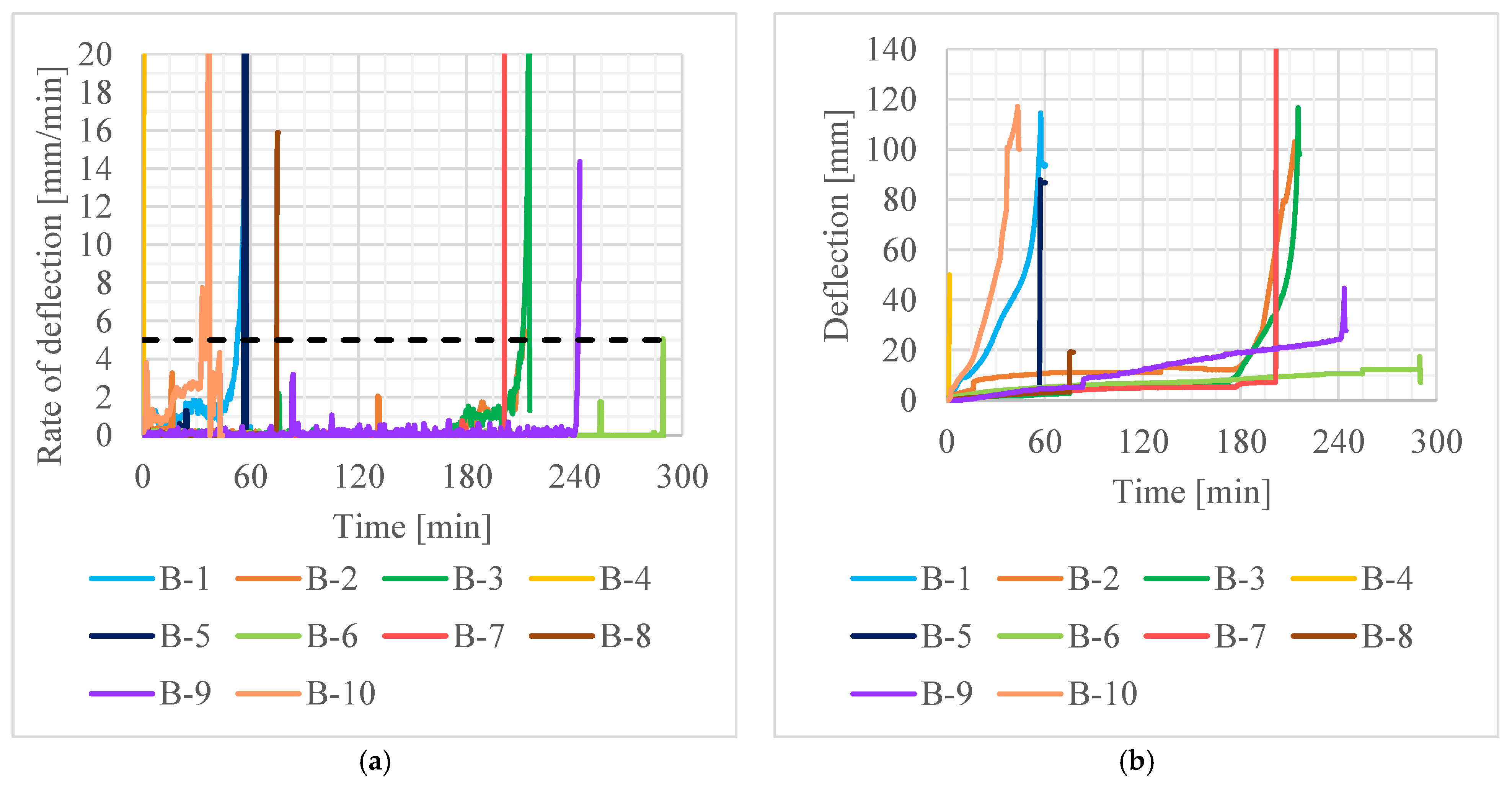

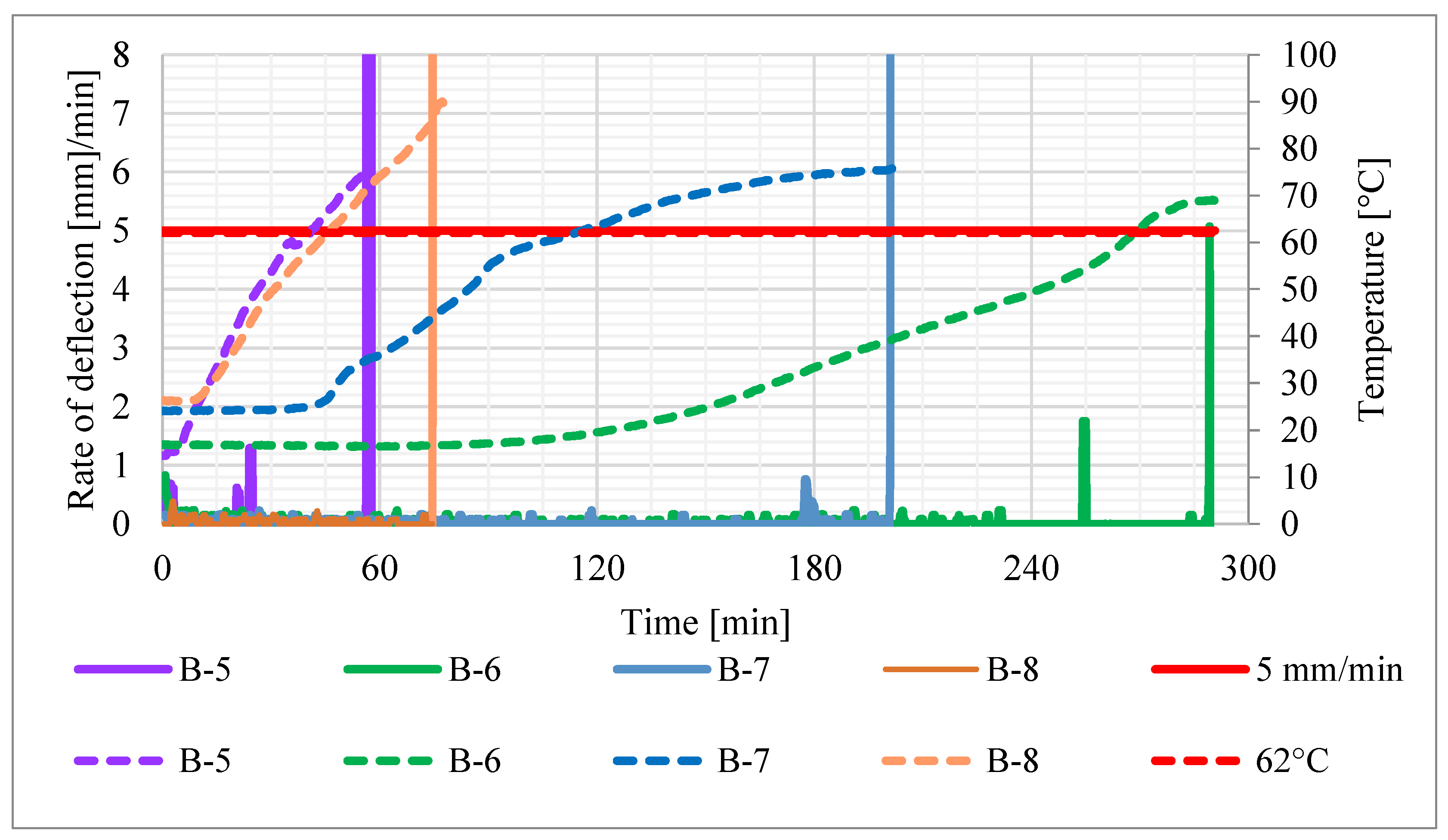
| Authors | Strength Increase [%] | Applied Load/Ultimate Capacity [%] | CFRP Failure Time [min] | Fire Resistance [min] |
|---|---|---|---|---|
| Deuring [6] | n.a. | 55 | 62–65 | >120 |
| Blontrock et al. [7] | 55 | 40 | 7–39 | >90 |
| Williams et al. [8] | 15 | 48 | 16–57 | >240 |
| Adelzadeh et al. [9] | n.a. | 71 | 30 | >240 |
| Ahmed and Kodur [10] | 50 | 50 | 20–25 | >180 |
| Firmo et al. [11] | 94 | 47 | 23–167 | >210 |
| Firmo and Correia [12] | 74 | 36 | 2–70 | >2–70 |
| Parameter | Designation | Value [kNm] |
|---|---|---|
| Design load-bearing capacity in normal conditions, before strengthening | MRd,RC | 36.8 |
| Design load-bearing capacity in fire conditions t = 0, before strengthening | MRd,0,fi,RC | 43.8 |
| Load-bearing capacity measured in strength test, before strengthening | MRd,RC | 55.0 |
| Design load-bearing capacity in normal conditions, after strengthening | MRd,CFRP | 71.1 |
| Load-bearing capacity measured in strength test, after strengthening | MR,CFRP | 81.0 |
| Design load-bearing capacity in normal conditions, before strengthening | MRd,RC | 36.8 |
| Design load-bearing capacity in fire conditions t = 0, before strengthening | MRd,0,fi,RC | 43.8 |
| Beam No. | Strengthening | Fire Protection | Bending Moment in Test [kNm] | Applied Load/Ultimate Capacity [%] |
|---|---|---|---|---|
| B-1 | CFRP 50 × 1.2 mm | none | 44 | 62 |
| B-2 | none | GB, 25 mm | 44 | 100 |
| B-3 | CFRP 50 × 1.2 mm | GB, 25 mm | 44 | 62 |
| B-4 | CFRP 50 × 1.2 mm | none | 71 | 100 |
| B-5 | CFRP 50 × 1.2 mm | GB, 25 mm | 71 | 100 |
| B-6 | CFRP 50 × 1.2 mm | GB, 150 mm | 71 | 100 |
| B-7 | CFRP 50 × 1.2 mm | CSB, 150 mm | 71 | 100 |
| B-8 | CFRP 50 × 1.2 mm | CSB, 50 mm | 71 | 100 |
| B-9 | CFRP 50 × 1.2 mm | CSB, 50 mm | 56 | 79 |
| B-10 | CFRP 50 × 1.2 mm | none | 46 | 65 |
| Beam No. | tFRP [min] | tFP [min] | t(dD/dtlim) = tR [min] | Trf(tR) [°C] | TFRP(tFRP) [°C] | TFRP(tR) [°C] | D(tFRP) [mm] | D(tFP) [mm] |
|---|---|---|---|---|---|---|---|---|
| B-1 | 2.25 | n.a. | 52.75 | 506.0 | 196.5 | 911.1 | 0.2 | n.a. |
| B-2 | n.a. | 168.00 | 211.50 | 477.9 | n.a. | n.a. | n.a. | 12.2 |
| B-3 | 75.50 | 160.00 | 211.00 | 478.4 | 88.9 | 1127.9 | 2.8 | 6.1 |
| B-4 | 1.07 | n.a. | 1.07 | 16.9 | 70.4 | 70.4 | 0.3 | n.a. |
| B-5 | 56.50 | 56.50 1 | 56.50 | 68.4 | 75.4 | 75.4 | 3.4 | 3.4 2 |
| B-6 | 289.50 | 289.50 1 | 289.50 | 62.5 | 68.9 | 68.9 | 12.5 | 12.5 2 |
| B-7 | 201.75 | 201.75 1 | 201.75 | 56.2 | 75.2 | 75.2 | 7.1 | 7.1 2 |
| B-8 | 75.00 | 75.00 1 | 75.00 | 70.1 | 85.8 | 85.8 | 3.4 | 3.4 2 |
| B-9 | 83.50 | 242.0 1 | 242.0 | 157.9 | 90.9 | 254.4 | 5.3 | 26.8 2 |
| B-10 | 2.25 | n.a. | 32.75 | 428.5 | 40.3 | 363.6 | 1.3 | n.a. |
Disclaimer/Publisher’s Note: The statements, opinions and data contained in all publications are solely those of the individual author(s) and contributor(s) and not of MDPI and/or the editor(s). MDPI and/or the editor(s) disclaim responsibility for any injury to people or property resulting from any ideas, methods, instructions or products referred to in the content. |
© 2023 by the author. Licensee MDPI, Basel, Switzerland. This article is an open access article distributed under the terms and conditions of the Creative Commons Attribution (CC BY) license (https://creativecommons.org/licenses/by/4.0/).
Share and Cite
Turkowski, P. Fire Resistance of Fire-Protected Reinforced Concrete Beams Strengthened with Externally Bonded Reinforcement Carbon Fibre-Reinforced Polymers at the Full Utilisation Degree. Materials 2023, 16, 5234. https://doi.org/10.3390/ma16155234
Turkowski P. Fire Resistance of Fire-Protected Reinforced Concrete Beams Strengthened with Externally Bonded Reinforcement Carbon Fibre-Reinforced Polymers at the Full Utilisation Degree. Materials. 2023; 16(15):5234. https://doi.org/10.3390/ma16155234
Chicago/Turabian StyleTurkowski, Piotr. 2023. "Fire Resistance of Fire-Protected Reinforced Concrete Beams Strengthened with Externally Bonded Reinforcement Carbon Fibre-Reinforced Polymers at the Full Utilisation Degree" Materials 16, no. 15: 5234. https://doi.org/10.3390/ma16155234
APA StyleTurkowski, P. (2023). Fire Resistance of Fire-Protected Reinforced Concrete Beams Strengthened with Externally Bonded Reinforcement Carbon Fibre-Reinforced Polymers at the Full Utilisation Degree. Materials, 16(15), 5234. https://doi.org/10.3390/ma16155234






